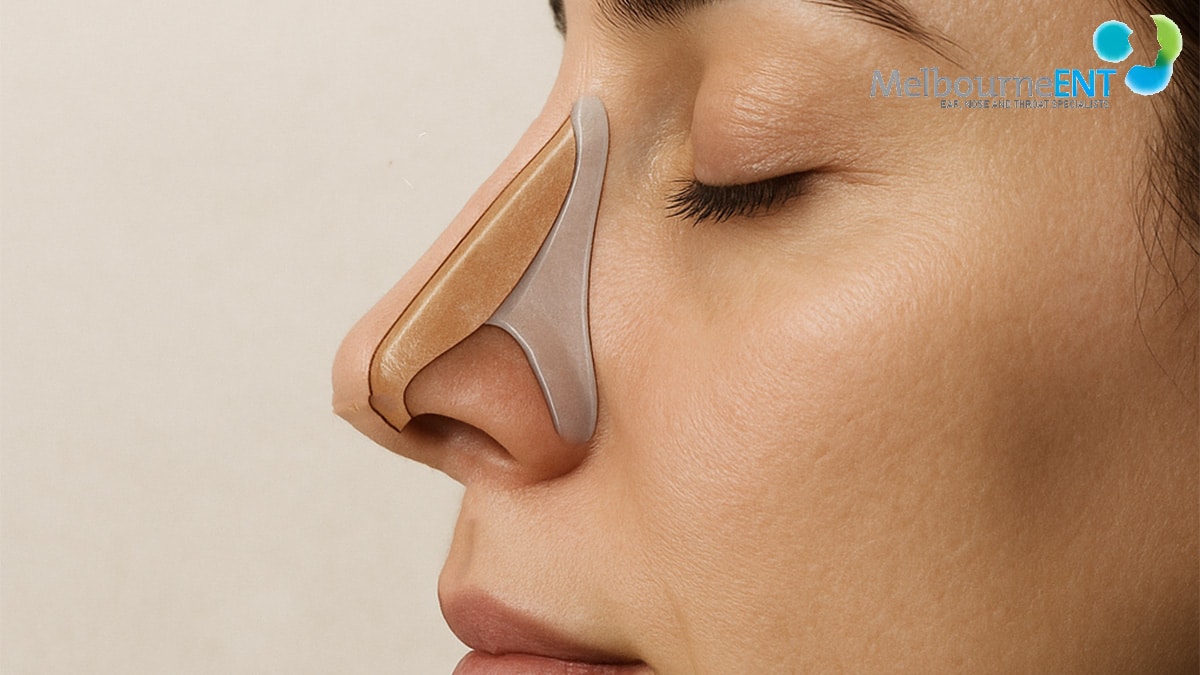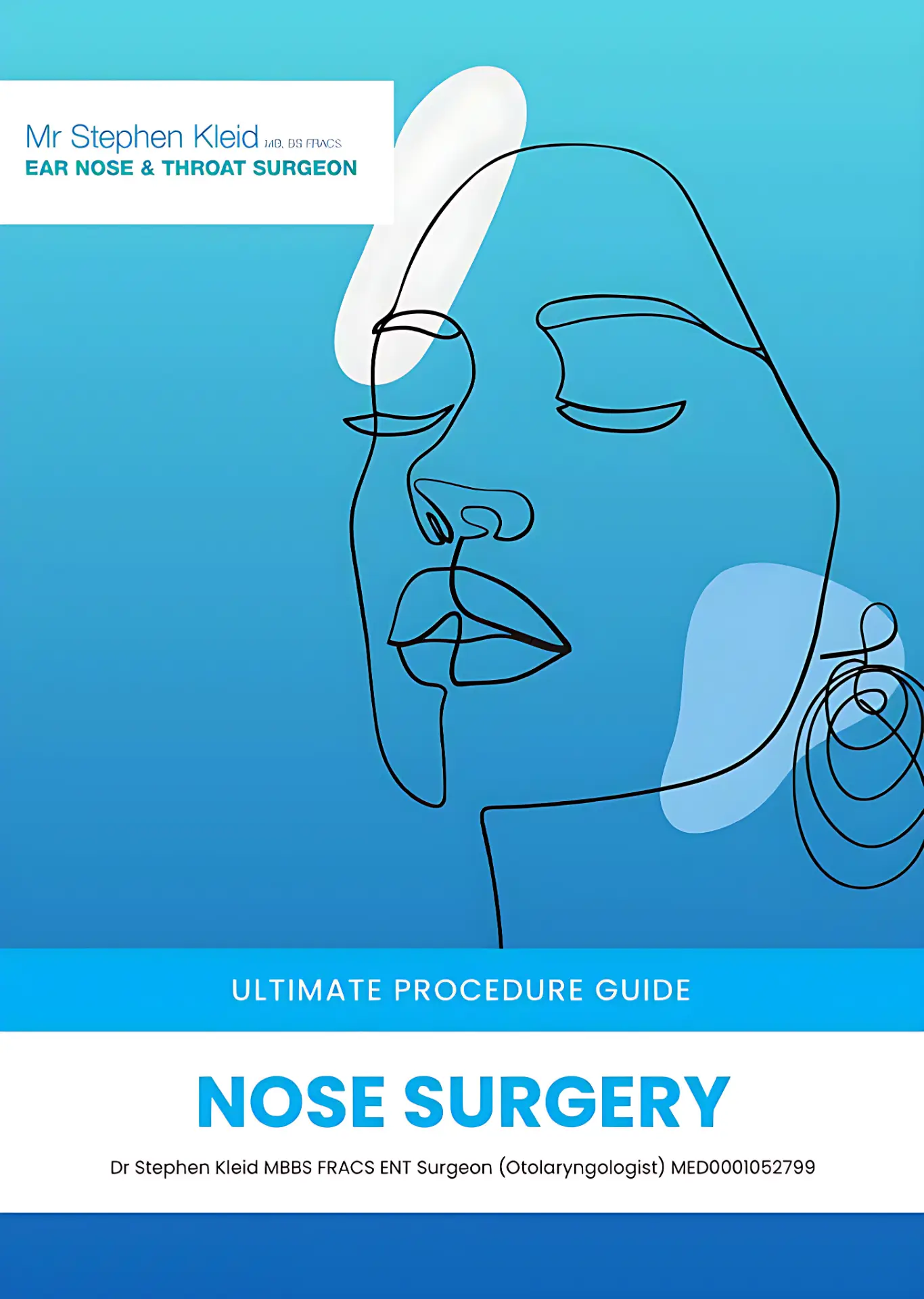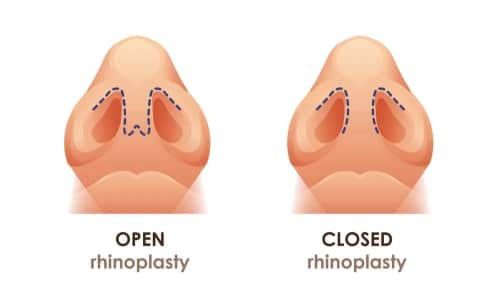
- Do you need a Cartilage Graft Rhinoplasty?
- DOWNLOAD GUIDE
- What Is Cartilage Graft Rhinoplasty?
- Types of Cartilage Grafts
- Who Might Consider This Procedure?
- Cartilage Graft Rhinoplasty Procedure
- Risks and Considerations
- Recovery and Aftercare
- How Much is a Cartilage Graft Rhinoplasty?
- Choosing the Best Nose Surgeon in Melbourne
- Questions to Ask in your Rhinoplasty Consultation
- Final Thoughts
- Cartilage Graft Rhinoplasty FAQs
- Medical References
Do you need a Cartilage Graft Rhinoplasty?
Cartilage graft rhinoplasty is a specialised form of nose surgery that involves the use of cartilage-usually harvested from the patient’s own body-to rebuild, support, or reshape the nasal structure. It is commonly used in both reconstructive and aesthetic nasal procedures.
Reconstructive uses may involve restoring form and function after trauma or previous surgery. Aesthetic uses may focus on improving nasal proportions or refining specific features. These types of grafts can be especially important in cases where the natural nasal structure is weak or has been compromised.
The cartilage graft provides extra support to weak or missing nasal tissue. It may also be used to enhance the nose’s appearance or to correct breathing issues related to nasal collapse. Patients seeking a solution to a previously unsuccessful nasal surgery or those born with nasal structural differences may find this technique valuable. This guide will walk you through the procedure, types of cartilage used, candidacy, risks, recovery, cost, and more.
DOWNLOAD GUIDE
Considering Rhinoplasty surgery? Information is just one click away.

What Is Cartilage Graft Rhinoplasty?
Cartilage graft rhinoplasty is a surgical procedure in which cartilage from another part of the body is used to reinforce or reshape areas of the nose. This approach is often used when there is a need to rebuild nasal anatomy, particularly in areas that have collapsed or require greater definition. Some patients seek this procedure to achieve improved balance or projection of the nose, while others require reconstruction due to prior injuries or medical interventions.
Cartilage is a flexible, firm tissue that the body generally accepts well. Autologous cartilage (taken from the patient) is preferred over synthetic materials because it reduces the risk of rejection and infection. In some cases, cartilage is used to enhance both structural stability and visual contouring, particularly when the nose needs to be supported internally to maintain a specific shape.
Common treatment areas include the nasal bridge, which may be built up to increase projection; the nasal tip, which can be refined or supported to maintain shape; and the nasal sidewalls or valves, where grafts can prevent inward collapse and aid breathing. Overall, cartilage graft rhinoplasty offers a reliable way to improve both form and function.
Types of Cartilage Grafts
Cartilage may be harvested from three primary donor sites within the patient’s body: the nasal septum, the ear, and the rib. Each source has unique properties that make it suitable for different surgical goals. The choice of cartilage type depends on the size of the graft needed, the structural demands of the surgery, and whether the patient has had previous procedures that affected the donor areas.
Septal Cartilage
Septal cartilage is harvested from the nasal septum, which is the central structure dividing the two nostrils. It is commonly used in primary rhinoplasty because it is accessible within the same operative field and provides a firm, straight material ideal for structural reinforcement. The harvesting process involves lifting the mucosa that lines the septum and carefully removing a portion of cartilage without compromising nasal stability.
Because of its straight shape and relative firmness, septal cartilage is especially useful for dorsal onlay grafts or septal extension grafts, where straight lines and firm support are required. However, its availability can be limited. In patients who have undergone previous nasal surgeries or have naturally thin septal cartilage, this source may not be suitable.
Ear (Auricular) Cartilage
Ear cartilage is typically harvested from the conchal bowl of the ear. This site provides curved, elastic cartilage that is more flexible than septal cartilage. The incision is usually made behind the ear and is hidden once healed. Because of its curvature, auricular cartilage is best suited for soft tissue contouring, such as in tip grafts or alar rim grafts.
Auricular cartilage is often used in revision surgeries when septal cartilage is unavailable. It can restore subtle nasal contours without adding excess bulk. While it is less structurally rigid, its curved nature can be beneficial in applications that require flexibility rather than strength. The ear typically retains its shape post-operatively, with minimal visible change or functional impact.
Rib (Costal) Cartilage
Rib cartilage is harvested from the costal margin, usually between the sixth and eighth ribs. It offers a generous supply of strong cartilage, making it the material of choice when large or load-bearing grafts are required. This includes procedures like major nasal reconstruction or when multiple grafts are needed in a single operation.
The procedure to harvest rib cartilage involves a separate incision, typically made just beneath the breast or in the lower rib cage area. The harvested cartilage is carefully carved to the desired shape. One of the challenges with rib cartilage is its tendency to warp over time. Surgeons often take precautions to reduce this risk, such as using layered grafting techniques or stabilising sutures. While the harvesting process is more invasive, the trade-off is a highly durable graft suitable for complex cases.

Who Might Consider This Procedure?
Cartilage graft rhinoplasty is considered in the following situations. Patients who have undergone previous nasal surgery, such as a primary rhinoplasty, may experience structural issues due to excessive removal of cartilage or scarring. Cartilage grafting can restore support, correct deformities, or address breathing problems caused by weakened nasal anatomy.
Trauma or injury to the nose is another common reason. Accidents, sports injuries, or fractures can lead to nasal collapse or deviation. In these cases, cartilage grafting is used to rebuild damaged sections and restore both appearance and function.
Some individuals are born with nasal structural differences that affect breathing or appearance. Conditions such as congenital saddle nose deformity or nasal valve collapse may require cartilage grafting to achieve a functional nasal airway and a balanced facial profile.
Ethnic rhinoplasty patients may seek subtle refinements that preserve cultural identity while enhancing the nose’s structural integrity. Grafts can be used to add projection or definition in a respectful and personalised way.
Determining eligibility for cartilage graft rhinoplasty requires a detailed medical evaluation, including nasal examination, medical history, and discussion of surgical goals. Not all patients require cartilage grafts, but for those who do, proper planning ensures an outcome that balances appearance and breathing function.
Cartilage Graft Rhinoplasty Procedure
The procedure begins with administration of general anaesthesia to ensure patient comfort. Once the patient is fully anaesthetised, the surgeon proceeds to harvest cartilage from the agreed donor site. This is a precise step that involves separating the cartilage while preserving nearby structures.
If septal cartilage is used, the surgeon accesses the nasal cavity and lifts the mucosal lining to remove the necessary portion. For ear cartilage, an incision is made behind the ear, and the conchal cartilage is removed in a way that maintains the ear’s shape. In rib grafting, a small incision is made over the rib cage, and a segment of cartilage is harvested with care to avoid damage to the surrounding tissue.
Next, the surgeon opens the nasal structure through either an open or closed approach. In an open rhinoplasty, a small incision is made on the columella, giving the surgeon full access to the underlying nasal framework. This approach is often used for complex reconstructions or revision surgeries.
The harvested cartilage is shaped into the desired form. It may be used to rebuild the bridge, reinforce the septum, project the tip, or stabilise the sidewalls. Once in place, the graft is secured with sutures, and any necessary adjustments are made to ensure balance and symmetry. The surgical site is then closed, and splints or dressings are applied to support the nose during the initial healing phase.
Risks and Considerations
Like all surgical procedures, cartilage graft rhinoplasty involves a set of risks that should be discussed in detail prior to surgery. These risks may include infection, which can occur at either the nasal site or the donor site. Infections are generally rare but may require antibiotic treatment or further intervention.
Bleeding is another potential risk during or shortly after surgery. While surgeons take steps to control bleeding during the procedure, some bruising or drainage may occur during recovery.
One of the more specific risks associated with cartilage grafting is the potential for graft warping. Rib cartilage, in particular, can change shape as it heals, which may affect the appearance of the nose. Surgeons use advanced techniques to minimise this, but a small risk remains.
Graft resorption, where the body partially absorbs the grafted tissue, may lead to subtle changes in shape over time. This risk varies depending on the graft source and individual healing responses.
There is also the possibility of contour irregularities or asymmetry, particularly in revision cases where scar tissue and altered anatomy complicate the surgical field. Donor site issues such as scarring, discomfort, or numbness may occur, especially with rib harvesting.
Risks related to anaesthesia, such as allergic reaction or respiratory complications, are rare but possible. The overall risk profile depends on the patient’s health status, the extent of the surgery, and the techniques used.
Recovery and Aftercare
Recovery from cartilage graft rhinoplasty involves several stages. During the first week, patients typically experience swelling, bruising around the eyes, and mild to moderate discomfort. A nasal splint is usually applied to protect and stabilise the nose. Breathing may be temporarily limited due to internal swelling and packing.
By the second week, much of the visible bruising will resolve. Patients often feel well enough to return to work or low-impact activities, although the nose will still be healing internally. It is important to follow activity restrictions, avoid wearing glasses on the nose, and continue sleeping with the head elevated.
Over the following weeks, swelling decreases, and the graft begins to integrate into the nasal structure. Exercise and heavier physical activities may be resumed cautiously, usually after 4 to 6 weeks, depending on your surgeon’s advice.
Full healing can take several months. In more complex or revision cases, final results may not be visible until 9 to 12 months after surgery. Rib grafts may involve an additional healing process at the donor site, with soreness or limited movement in the early weeks.
Regular follow-up visits are important to monitor healing, identify any early issues, and make minor adjustments if needed. Patients should also be aware of long-term care instructions, such as avoiding trauma to the nose and protecting it from sun exposure.
How Much is a Cartilage Graft Rhinoplasty?
The cost of cartilage graft rhinoplasty varies across Australia and depends on several important factors. These include the complexity of the procedure, the number of grafts required, and whether the surgery is primary or a revision. The need for additional procedures, such as nasal valve repair or airway correction, can also influence cost.
Hospital and anaesthesia fees are often separate from the surgeon’s fee. Facilities that offer accredited day surgery or overnight hospital stays may charge based on theatre time and recovery needs. Additional costs may include pre-operative imaging, post-operative care, and specialised nursing support.
When the surgery is performed to improve nasal function-such as correcting a collapsed nasal valve or restoring airway patency-some costs may be partially covered by Medicare or private health insurance. This depends on meeting specific criteria and may involve item numbers recognised by the Medicare Benefits Schedule.
During your consultation, the surgeon’s team will provide a detailed quote. It is important to ask what is included, such as follow-up visits or revision policy. Cost transparency helps patients plan appropriately and avoid unexpected expenses.
Choosing the Best Nose Surgeon in Melbourne
Selecting the right surgeon is a key part of preparing for cartilage graft rhinoplasty. It is recommended to choose a surgeon who is a FRACS (Fellow of the Royal Australasian College of Surgeons). This indicates that they are a surgeon.
Surgeons who perform rhinoplasty regularly in hospital-accredited theatres are more likely to be familiar with the nuances of graft selection, donor site care, and nasal anatomy. Experience with complex cases, such as revisions or rib grafting, is particularly relevant if your procedure involves significant reconstruction.
The AHPRA public register allows patients to verify a surgeon’s qualifications, registration status, and practice restrictions. The Royal Australasian College of Surgeons also maintains a searchable list of Fellows through its “Find a Surgeon” tool.
Choosing a qualified practitioner also means selecting someone who communicates clearly, provides evidence-based guidance, and respects patient autonomy throughout the process. A well-informed and collaborative approach contributes to a safer and more satisfying experience.
Questions to Ask in your Rhinoplasty Consultation
Patients preparing for cartilage graft rhinoplasty should attend the consultation with clear, thoughtful questions. Understanding the plan and the reasons behind surgical choices helps patients make informed decisions.
You may want to ask your surgeon about the type of cartilage recommended for your nose, including the reasons for selecting septal, ear, or rib cartilage. If septal cartilage is not available, ask about the harvesting process for alternative sites and what the recovery will be like at those locations.
Ask how many similar procedures the surgeon has performed, particularly those involving rib grafts or complex revisions. Enquire about the risks that are most relevant to your case, including warping, resorption, or donor site complications. Also, ask about the expected healing timeline, possible changes in shape over time, and how the final results are monitored.
Understanding the cost breakdown is also important. Ask for an itemised estimate, what is included in the fee, and whether follow-up visits or additional care are covered. If you may be eligible for Medicare or insurance rebates, clarify how this process works and what documentation is needed.
Final Thoughts
Cartilage graft rhinoplasty is a valuable surgical option for patients who require structural support, functional repair, or aesthetic refinement of the nose. Whether addressing complications from a previous procedure, correcting congenital issues, or enhancing nasal contour, cartilage grafts offer a durable and adaptable solution.
The procedure involves careful selection of cartilage from the septum, ear, or rib, and placement into the nose to restore form and function. Results depend on individual anatomy, healing patterns, and surgical technique. While the recovery can be extensive in some cases, long-term outcomes are generally stable and effective.
Every patient is different. The best way to determine whether this procedure is right for you is to meet with a qualified Specialist Surgeon. A detailed consultation will ensure your goals, expectations, and health needs are fully addressed.
Cartilage Graft Rhinoplasty FAQs
Can I still have a cartilage graft if I’ve had multiple nose surgeries in the past?
- Yes, but the choice of cartilage source may be limited. If your septal cartilage was used in previous surgeries, your surgeon may recommend ear or rib cartilage. A detailed examination is necessary to determine what’s possible in your specific case.
Will the cartilage feel different to the touch once it’s inside my nose?
- In most cases, the graft integrates well with your existing nasal tissues. It should not feel noticeably different to the touch after healing, though areas with thicker cartilage may feel slightly firmer.
Is it possible to use cartilage from another person or synthetic material instead?
- While technically possible, using cartilage from another person (cadaveric graft) or synthetic materials increases the risk of rejection or complications. Most surgeons prefer to use your own cartilage when feasible.
What happens if the graft is absorbed or changes shape over time?
- Graft absorption or warping can occasionally occur, particularly with rib cartilage. Surgeons use techniques to minimise this risk, but long-term changes may happen. These changes are usually minor and not noticeable without close examination.
Will harvesting cartilage from my ear or rib change the way those areas look?
- Surgeons take great care to minimise visible changes. Ear cartilage is taken from areas that don’t affect ear shape, and rib cartilage is removed through a small, concealed incision. Most patients heal with little visible difference.
Can cartilage graft rhinoplasty help improve breathing problems caused by structural issues?
- Yes, one of the main uses of cartilage grafts is to reinforce areas of the nose that have collapsed or narrowed, such as the internal nasal valve. This can help improve airflow and reduce nasal blockage.
If I need a touch-up in the future, can the same cartilage graft be adjusted?
- Minor adjustments are sometimes possible, but it depends on the type and location of the graft. In some cases, a small amount of new cartilage may need to be harvested to make corrections.
Medical References
- Frozen Cadaveric Rib Grafts in Primary or Revision Rhinoplasty
Plastic and Reconstructive Surgery – Global Open
This meta-analysis evaluates outcomes and complication rates of fresh frozen cadaveric rib grafts, showing low complication rates and potential advantages over autologous and irradiated grafts.
https://pmc.ncbi.nlm.nih.gov/articles/PMC11984773/ - Long-Term Resorption Rates of Conchal and Rib Cartilage Grafts in Nasal Tip Plasty
Aesthetic Plastic Surgery (Springer)
This study compares long-term resorption rates between conchal and rib cartilage grafts, finding rib cartilage provides superior long-term stability.
https://pubmed.ncbi.nlm.nih.gov/39890635/ - Rhinoplasty Septal Cartilage Harvest and Reconstruction: The 4 Clicks
Plastic and Reconstructive Surgery – Global Open
Describes a systematic technique for septal cartilage harvest maximizing graft material and improving septal deviation correction.
https://journals.lww.com/prsgo/fulltext/2025/01000/rhinoplasty_septal_cartilage_harvest_and.21.aspx - Dorsal Augmentation Rhinoplasty by Cartilage Allograft
Journal of Cosmetic Dermatology (Wiley)
Evaluates long-term outcomes and patient satisfaction following nasal dorsal augmentation using allogeneic cartilage grafts.
https://onlinelibrary.wiley.com/doi/10.1111/jocd.16724 - A Novel Technique: Scored Conchal Cartilage to Simulate Natural Curvature for Tip Grafting
Polish Journal of Otolaryngology
Introduces a new method using scored conchal cartilage to mimic natural tip curvature, providing an alternative graft option.
https://pjohns.pso-hns.org/index.php/pjohns/article/view/2443 - Insights from an International Survey of Facial Plastic Surgeons on Cartilage Graft Preferences
European Annals of Otorhinolaryngology, Head and Neck Diseases (ScienceDirect)
Discusses graft preferences among surgeons, highlighting septal cartilage as favorable for primary rhinoplasty but limited in availability.
https://www.sciencedirect.com/science/article/abs/pii/S1010518225000472 - Aesthetic and Functional Outcomes of Combined Use of Extended Spreader Graft and Septal Extension Graft in Septorhinoplasty
Life Journal (MDPI)
Explores technical considerations and outcomes of combined cartilage graft techniques to improve nasal function and aesthetics.
https://www.mdpi.com/2075-1729/15/4/546





